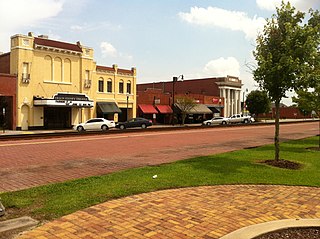
Dillon is a city in Dillon County in eastern South Carolina, United States. It is the county seat and largest city of Dillon County. It was established on December 22, 1888. Both the name of the city and county comes from James W. Dillon, an early settler and key figure in bringing a railroad through the area. The population was 6,788 in the 2010 U.S. census.

Latta is a town in Dillon County, South Carolina, United States. Latta is the second largest town in Dillon County. As of the 2010 census, it had a population of 1,379.

The Abbeville County Courthouse, built in 1908, is an historic courthouse located in the east corner of Court Square, in the city of Abbeville in Abbeville County, South Carolina. It was designed in the Beaux Arts style by Darlington native William Augustus Edwards who designed several other South Carolina courthouses as well as academic buildings at 12 institutions in Florida, Georgia and South Carolina. An arcade connects it to the adjoining Abbeville Opera House and Municipal Center, which Edwards also designed. In 1964, the courthouse was renovated by Lyles, Bissett, Carlisle, and Wolff of Columbia. On October 30, 1981, it was added to the National Register of Historic Places. It is included in the Abbeville Historic District.

The Dillon County Courthouse, built in 1911, is a historic courthouse located at 301 West Main Street in the city of Dillon in Dillon County, South Carolina. It was designed in the Classical Revival style by Darlington native William Augustus Edwards who designed eight other South Carolina courthouses as well as academic buildings at 12 institutions in Florida, Georgia and South Carolina. Dillon County was created in 1910 and this is the only courthouse it has ever had. On October 30, 1981, it was added to the National Register of Historic Places. It is located in the Dillon Downtown Historic District.

The Shackelford County Courthouse Historic District is a historic district in Albany, Texas. It is roughly bounded by South 1st, South 4th, South Jacobs, and South Pecan Streets, centered on the courthouse square. Added to the National Register of Historic Places in 1976, the district includes the Shackelford County Courthouse and a number of surrounding Victorian buildings dating from the late nineteenth and early twentieth centuries.

The Tarboro Cotton Press, which is also called the Norfleet Cotton Press or the Edgecombe County Cotton Press, is a wooden cotton press built in the mid-18th century in Edgecombe County, North Carolina. It was moved to the Tarboro Town Common of Tarboro, North Carolina. It was named to the National Register of Historic Places on February 18, 1971. It is located in the Tarboro Historic District.
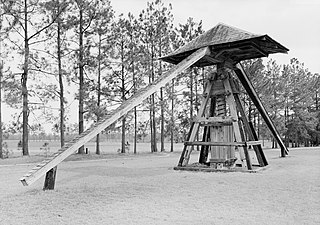
The Latta Cotton Press is an early mule-powered, wooden cotton press built around 1798. It was built and operated at Berry's Crossroad on South Carolina Highway 38 south of Latta in Dillon County, South Carolina. It was moved about 2.5 mi (4 km) west around 1950. It was listed on the National Register of Historic Places on November 15, 1972.

This is a list of the National Register of Historic Places listings in Dillon County, South Carolina.
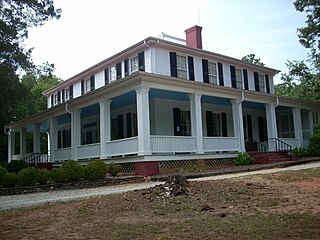
Ashtabula is a plantation house at 2725 Old Greenville Highway near Pendleton in Anderson County, South Carolina, USA. It has been also known as the Gibbes-Broyles-Latta-Pelzer House or some combination of one or more of these names. It was named in the National Register of Historic Places as a historic district on March 23, 1972. It is considered a significant example of a Lowcountry style plantation house built for a Charleston family in the Upstate in the early 19th century. It also is part of the Pendleton Historic District.

Catfish Creek Baptist Church is a historic Southern Baptist church located near Latta, Dillon County, South Carolina. It was built in 1883, and is a pine structure measuring 60 feet long and 40 feet wide. The front façade features brick steps and brick pedimented portico with four supporting columns added in 1970. It is the oldest church congregation in Dillon County, dating to 1802.
Old Ebenezer Church, also known as Ebenezer Methodist Episcopal Church, South, is a historic church located near Latta, Marion County, South Carolina. It was built in 1856, and is a one-story, rectangular meeting house style frame church sheathed in white clapboard. It has two entrances on the main façade, corresponding doors on the rear façade, and a gable roof.

James W. Dillon House is a historic home located at Dillon, Dillon County, South Carolina. It was built in 1890, and is a two-story, white frame Late Victorian style dwelling. A one-story veranda extends across the façade and three-fourths of the southeast elevation. Other notable details include lattice work, carved posts with cornice braces, scalloped shingles in gables, and an ornate front gable with gingerbread trim. It was the home of James W. Dillon, founder of the town and man for whom the county was named.
Joel Allen House is a historic home located near Latta, Dillon County, South Carolina. It was built in 1857, and is a two-story, frame South Carolina upcountry farmhouse. It is sheathed in weatherboard and has an interior floor plan of two rooms flanking a central hall. It features a full-width front porch supported by six square wooden columns. Located on the property are the contributing smokehouse, wash house, commissary, stable, and barn.

McMillan House is a historic home located at Latta, Dillon County, South Carolina. It was built about 1890, and is a 2+1⁄2-story, frame, weatherboarded, Second Empire style residence. It has a mansard roof and features a one-story, hip-roofed porch, and a gabled entrance portico with sawtooth shingles. The front façade also has a central projecting bay. It was the home of S.A. McMillan, one of Latta's prominent early businessmen.
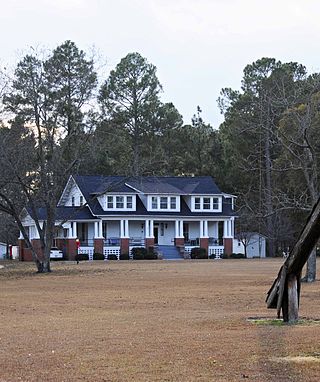
John Hayes Farmstead, also known as Cotton Press Farm and John Hayes House, is a historic home and farm located near Latta, Dillon County, South Carolina. The main house was built in 1791, later extensively renovated and expanded as an American Craftsman / Bungalow house in 1915. It is still a working farm, producing tobacco, corn, grains, and soybeans, and in 1988 was recognized by the U.S. Department of Agriculture as a Bicentennial Farm. Also on the property are a sweet potato curing house, three barns, smokehouse, wash house, and pump house.
Latta Downtown Historic District is a national historic district located at Latta, Dillon County, South Carolina. The district encompasses 13 contributing buildings in the central business district of Latta. The buildings were erected between about 1895 and 1928. They include buildings that housed a variety of mercantile establishments such as grocery stores, drugstores, a hotel, two banks, and several dry goods stores concentrated in a block east of the railroad on Main Street. Notable buildings include the Parham Building, McMillan Building, Cox Building, and Kornblut's Department Store.

Latta Historic District No. 1 is a national historic district located at Latta, Dillon County, South Carolina. The district encompasses 47 contributing buildings in a primarily residential section of Latta. The buildings were erected between about 1890 and 1930. The houses are mostly one- to two-story frame residences with late Victorian era details. In addition, the district has examples of local usage of neo-classical details and more sophisticated examples of the Neo-Classical style. Early 20th century bungalows illustrate the development of the area during the early century. The district also contains the Latta Public Library, the Latta Methodist Church, the Latta Baptist Church, and a few commercial buildings, most notably the Fairey Agency and Dr. L.H. Edwards dentist office.

Dillon Downtown Historic District is a national historic district located at Dillon, Dillon County, South Carolina. The district encompasses 66 contributing buildings in the central business district of Latta. The buildings were erected between about 1903 to 1948. The district's buildings reflect the one- and two-part commercial blocks found in towns throughout the nation and represent stylistic influences ranging from late Victorian period examples displaying elaborate brick-corbeled cornices and pediments to the more simplified and minimalist Depression-era examples with typical low relief detailing and vertical piers. The 1911 Neo-Classical Dillon County Courthouse, corner stores and banks featuring Classical Revival vocabulary, the brick depot, other highly decorative buildings, as well as modest but intact commercial stores help to define and anchor the district along both the town's Main Street and its intersecting railroad corridor.
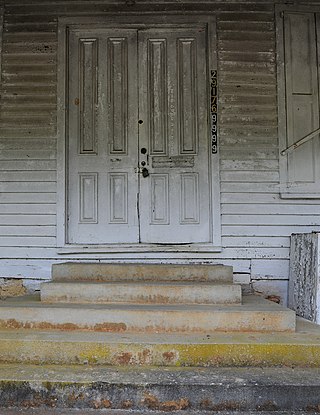
White Oak Historic District is a national historic district located near Winnsboro, Fairfield County, South Carolina. The district encompasses 12 contributing buildings in the rural community of White Oak. The buildings in the district were built between about 1876 and about 1925, and includes three large frame residences, a frame church with steeple, two frame store buildings, a cotton warehouse, and two vacant, wooded lots, some of which reflect Victorian stylistic influences. Notable buildings include the T. G. Patrick Store, McDowell's Store, White Oak Cotton Warehouse, Matthew Patrick House, T. G. Patrick House and outbuildings, and White Oak A.R.P. Church and Manse.

Winnsboro Historic District is a national historic district located at Winnsboro, Fairfield County, South Carolina. The district encompasses 33 contributing buildings and 1 contributing site in the county seat of Winnsboro. The district features a wide range of architectural styles, from early simple frame houses that reflect utilitarian aspects of the Scotch-Irish, the first principal settlers, to pronounced styles such as Federal and Greek Revival. Many residences are typical upcountry frame houses, built in an L-shape with long piazzas running across the front. Notable buildings include the Town Clock, Fairfield County Courthouse, Thespian Hall, Fairfield Country Club, Mt. Zion Elementary, the separately listed Ketchin Building, Beatty House, Wolfe House, Kirkpatrick House, Neil House, and Williford House / Town Hall. The Fairfield Country Club was built in 1822 under the supervision of Robert Mills.





















